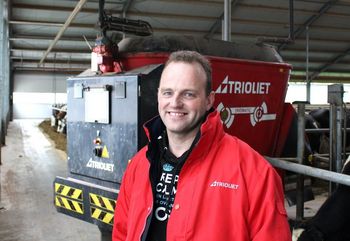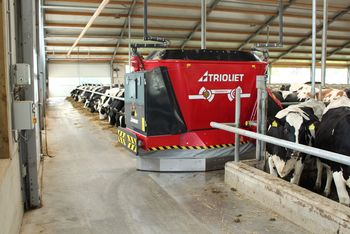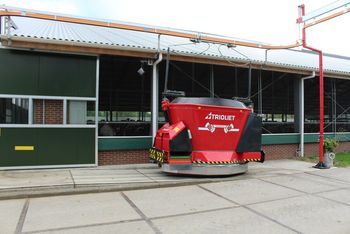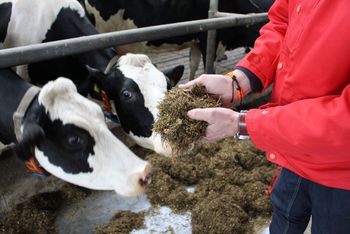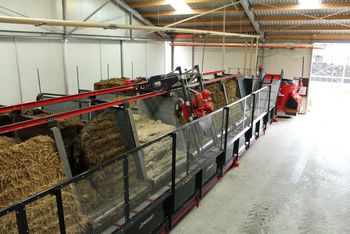It is remarkably calm in the stables, the cows are lying around contentedly chewing their cud or standing curiously by the gate. There's nothing to show how hard at work they are. Mr. Verweij is a dairy farmer and cheesemaker. Together with his wife and two brothers, he runs the family business in Polsbroek (the Netherlands). Together, their 340 dairy cows produce 10,000 kg of Gouda cheese a week.
Cheese from the Farm
All Verweij cheeses carry the national "farmhouse cheese" certification. The cheese is traditionally made according to the strict quality standard for food safety, the Dairy Farm Quality Assurance. This means that they must meet high standards as to hygiene and that both the stables and the cheese dairy are subject to routine inspections. "We milk as cleanly as possible and keep the stables extra neat," says Verweij.
"Milk Quality is the Main Factor"
For a tasty raw milk cheese, the quality of the milk is the most important factor. The milk that Verweij produces has a fat content of 4.6% and a protein content of 3.9%. These great milk contents are the result of carefully composed feed rations. "If the rations are off, you can tell immediately from the resulting hoof problems, manure structure, milk production and the milk content levels. A lower fat content may mean that there is too little structure to the feed or that the cows are feeding selectively." That is why it is important to create well-balanced rations and then mix them as thoroughly as possible. The rations at Verweij are comprised of grass silage, corn, pressed pulp, hay, concentrates and minerals. The company supplies nearly all of its own roughage from 120 hectares of grassland and 10 hectares of corn.
Automatic feeding system as an extra employee
When the stables were rebuilt in 2014, Verweij decided to implement an automatic feeding system. "The capacity of the Triomatic system was the deciding factor for me. We feed the dairy cows 18 times a day and the other groups 12 times. If we didn't have such a good feeding robot, we would have to hire extra personnel. But even then, we wouldn't have the flexibility we have now. In the past, we would feed a maximum of 4 loads a day using a feed mixer. This also cost much more time. We lost about six hours a day to ensilaging, filling the feed mixer and discharging the feed. Now, all we have to do is replenish the feed kitchen, which we usually do on Mondays, Wednesdays and Fridays. The feeding costs us a total of 12 hours a week which includes the silage work and adapting the rations. The feeding continues as normal on weekends without us needing to do a thing. This makes us enormously flexible as we can now utilize this time saved to do something else. Another advantage is that we can easily adapt the feeding to, for example, the weather conditions. If it's very hot during the day, we can set the system so that less feed is served during the feeding periods. After it cools down in the evening, a higher quantity or extra feeding period can be activated. In this way, we can optimally respond to circumstances and to the cows' needs."
In many ways, the Triomatic automatic feeding system contributes to a cleaner, healthier environment for both humans and animals. Not only is it equipped with the Trioliet cutting system that consumes less power but there is also no tractor needed to drive through the stable with dirty tyres, unhealthy exhaust gases and a high fuel consumption. Furthermore, the stable is kept quieter as the cattle are offered feed several times a day. Thanks to this higher feeding frequency and the freshness of the feed, the cows are able to absorb more nutrients from the feed. More regular and structured feeding leads to better digestion and rumen function among the cows. Due to its low energy consumption and a healthier livestock, the Triomatic can also be counted among Trioliet's green products.
Less Feed Concentrate Needed
The second deciding factor for Verweij in choosing the Triomatic feeding robot is the mixing quality. Verweij: "Since implementing the Triomatic system, the stables are quiet and our feeding efficiency has increased considerably. The robot mixes really well, the cows can't be selective and that translates to better returns. Thanks to the excellent mixing results, we now need much less concentrate than we used to."
The cows look content. Every cow has its own spot and there is no competition at the feeding gate. In another hour, they'll go to be milked. The next morning, their "white gold" will be made into cheese. Part of Verweij's artisanal cheese is sold through cheese specialty shops and part of it is exported to France, England, Croatia and the United States. A great example of Dutch craftsmanship.
Name: Mr. Verweij
Company: Cheese farm Verweij in Polsbroek (Utrecht), the Netherlands
Number of dairy cows: 340
Workers: 6 full-time employees
Feeds with: Triomatic T40 New Edition Automatic feeding system with self-propelled feeding robot
Feed efficiency: 1.57
Is robotic feeding interesting on your farm?
